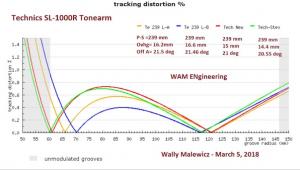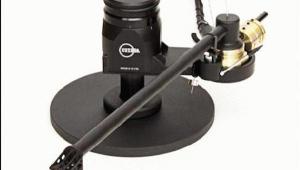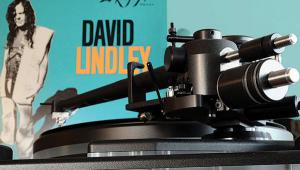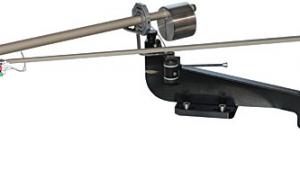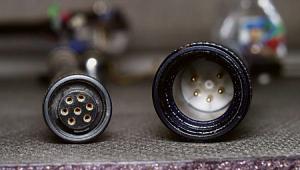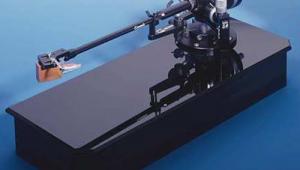Kuzma 4Point tonearm Page 3
Rather than remove the Ortofon A90 cartridge from the Cobra, I decided to return the Lyra Titan i to service after a lengthy break. I had high expectations, because I know the Lyra's sound so well.
Those expectations were exceeded. The 4Point had an immediacy, a transparency, and an evenhandedness of frequency response that surpassed those of any other tonearm I've heard, possibly including the Cobra—though I've not yet swapped out the A90 for the Titan i. Why haven't I? Because what I was hearing from the Kuzma-Lyra combo was just too good to lose. It would have to wait until tomorrow . . . and then the next day . . . and then I was past deadline.
The 4Point revealed all of the Lyra Titan i's best qualities—dynamics, transparency, resolution of detail—with unsurpassed intensity, while my one reservation about this cartridge, an apparently tipped-up top end, was nowhere to be heard. I'd never heard the Titan i sound so tonally well balanced.
Late one warm evening came my first playing with the 4Point of Brian Eno's classic Another Green World. How many plays have my original UK and Japanese pressings had since their release in late 1975? I can't count, but I enjoy the album as much now as I did then—though it sounded much better now! Through the 4Point, Percy Jones's fretless bass achieved a tactile stickiness that was both delicate and depth-charged as needed, which is what's called for, but I'd never heard it reproduced so cleanly and convincingly.
It was easy enough to switch to the Cobra-A90 combo; I went back and forth many times, and the two tonearm-cartridge pairings produced completely different results. The Cobra-A90 sounded more polite and perhaps more nuanced and delicate than the Kuzma-Lyra, but far less immediate and transparent—as if a scrim had appeared between me and the music. The Kuzma-Lyra sounded more like tape, less like vinyl—or at least that's what I kept telling myself.
I had another cartridge mounted in the second headshell supplied with the Kuzma: the Miyajima Labs Kansui, which, to put it as simply as possible, is a higher-compliance, higher-resolution Miyajima Shilabe. Swapping out cartridges produced a totally different sound, as you'd expect from a change of transducers, but again—the immediacy and transparency of the 4Point were transferred to the Kansui, so that the cartridge's character shone through unimpeded by the arm.
Running through a series of test pressings of familiar music from Quality Record Pressings produced equally exalted results, particularly in terms of low-level resolution and fade-to-black quiet (wait'll you hear Analogue Productions' 45rpm edition of Getz/Gilberto, transferred from the original three-track master!). As familiar tracks faded out, there seemed to be more music before the final silence.
Swapping between the Cobra (no slouch!) and the 4Point confirmed the Kuzma's ability to stabilize solid, three-dimensional images and sail cleanly through difficult passages of vocal sibilants across the entire record surface.
Perhaps the music—covers of "People," "Days of Wine and Roses," and other '60s pop—on the Oscar Peterson Trio's We Get Requests isn't the greatest, but the recording is. The 45rpm test pressing (two 200gm LPs, Verve/Analogue Productions AVRJ 8606-45) demonstrated the 4Point–Titan i's ability to reproduce Peterson's piano with a timbral, textural, and image solidity, plus transparency, that the Cobra-A90 did not. The latter's version was very, very good, but individual notes didn't have the same level of purity and cohesiveness. Keystroke after keystroke, the Kuzma-Lyra produced a physical certainty and solidity that the Cobra-A90 seemingly didn't.
I'd been repeatedly playing "Teeter Totter," from Joe Henderson's Our Thing (45rpm, Blue Note/Music Matters MMBST-84152), and though it's a good Rudy Van Gelder recording, Andrew Hill's piano has the characteristic Rudy piano mud. The 4Point cut through and cleared up a remarkable amount of that muck, to reveal a gleaming keyboard sound. The Cobra-A90 was good, but not as coherent or immediate or three-dimensional.
Until I'd made these comparisons, I didn't think it could get any better than the Cobra. Now I'm not sure. From bottom-end clarity and weight to image solidity and three-dimensionality to seemingly neutral tonal balance and remarkable transparency, the Kuzma 4Point surpassed the Cobra's excellence in all of these parameters. What accounts for the difference? The damping the Cobra lacks may be part of it, but I think it's more a result of the 4Point's stability coupled with the tightness of its chatter-free bearing.
I plan to use my Alesis Masterlink hard-disk recorder to make 24-bit/96kHz recordings of the Kuzma 4Point and Lyra Titan i, with and without damping, as well as of the Continuum Cobra and Ortofon A90, then swap out cartridges and repeat. Stay tuned.
In the meantime, I think the Kuzma 4Point is a better tonearm than the tangential-tracking Kuzma Airline that I reviewed in April 2007. I value the 4Point's tonal correctness more than I do whatever audible (or, in my book, mostly inaudible) tracking-error distortions are caused by pivoted playback, and I think the 4Point avoids a brightness I couldn't tame in the Airline, and that listeners at a Consumer Electronics Show picked out immediately when, in various exhibit rooms, I played CD-Rs I'd recorded from it. Was that brightness caused by an oscillation at the annular gap and the high-pressure air returning to ambient room pressure? I have no idea.
Conclusions
As I wrote at the beginning, the quality of a tonearm's bearing has a profound impact on its sound, and I'm not sure there's a better bearing system than what Franc Kuzma has designed for the 4Point. He's come up with new and ingenious uses of well-known technologies, the up- and downsides of which are well known, and which he's seemingly avoided.
What I do know is that while I'm hesitant to call anything "the best," unless the cartridge swap described above changes things, I can definitely say that the Kuzma 4Point produced the best performance from the Lyra Titan i that I've ever heard from it in my system: the best tracking, the best tonal balance, the best imaging, the best (and most remarkable) cleanness of vocal sibilants. The Lyra's bass performance was as deep, fast, and nimble as I've ever heard it, and its image solidity and soundstaging in general were also the best I've heard from this cartridge.
The sound the 4Point produced had an immediacy, continuity, transparency, linearity, and freedom from mechanical artifice that, until now, I'd thought could be heard only from open-reel tape. Oh, I might have said that before, and others surely have—but this time, dammit, I mean it!
Add to that mechanical robustness, ease of cartridge swapping and setup, and an effective mass that should allow it to be used even with a high-compliance cartridge such as Shure's V15VxMR (though the Shure's resonant frequencies will be on the margin of acceptability), and you have one incredible tonearm. I'm in love.
- Log in or register to post comments


I noticed that in your review of the Kuzma 4Point 9 in the current issue of Stereophile (June 2018 issue) that you make mention of the fact that this new arm is more compatible with the Linn LP12 platform. Unfortunately, this is reported to actually NOT be the case! There are several users in Europe who have tried this combo, all have been severely disappointed! The suspension of the Linn requires a very light weight arm...along with cabling that has no way of interfering with the subchassis and bounce. As a current LinnLP12 Radikal D owner, I know this as a fact. The LP12 is VERY unforgiving when it comes to arms and the compatibility with weight, design etc. Did you happen to check the new Kuzma 4point 9 on a LP12 table?
